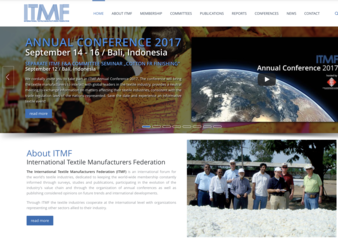24.05.17 – International Textile Manufacturers Federation (ITMF)
Shipments of new textile machinery in 2016 vary between segments
The 39th annual International Textile Machinery Shipment Statistics (ITMSS) is just released by the International Textile Manufacturers Federation (ITMF?)
Shipments of long-staple spindles and open-end rotors were up, while those of short-staple spindles were down.
Shipments of draw-texturing spindles and circular-knitting machines decreased, while those of shuttle-less looms and electronic flat knitting machines increased.
Deliveries of new long-staple spindles and open-end rotors soared by nearly 111% and 66%, respectively from 2015 to 2016. The number of shipped short-staple spindles decreased in 2016 by 12% compared to the previous year. The number of shipped draw-texturing spindles fell by 14% and shipments for new circular knitting machines by 3% year-on-year. In contrast, deliveries of electronic flat knitting machines soared by 99% in 2016. In the segment of finishing machines (fabrics continuous), the number of stenters increased in 2016 year-on-year by 22%.
These are the main results of the 39th annual International Textile Machinery Shipment Statistics (ITMSS) just released by the International Textile Manufacturers Federation (ITMF). The report covers six segments of textile machinery, namely spinning, draw-texturing, weaving, large circular knitting, flat knitting and finishing. The 2016 survey has been compiled in cooperation with more than 140 textile machinery manufacturers, representing a comprehensive measure of world production. This number does not include the numerous Chinese companies that are represented by the so called “District”. Therefore, the amount of participating companies is likely to be around 200.
Spinning Machinery
Shipments of new short-staple spindles fell by nearly 12% year-on-year in 2016, the third decrease in a row. The level of short staple spindles declined to about 7.9 million spindles, the lowest level since 2009. Most of the new short staple sindles (92%) were shipped to Asia, whereby shipments fell by 12% year-on-year. Thereby China, the world’s largest investor of short-staple spindles, experienced an increase of 9%, whereas delieveries to Bangladesh, Indonesia and Vietnam rose by 97%, 4% and 31%, respectively. The six largest investors in short-staple spindles in 2016 where China followed by India, Bangladesh, Viet Nam, Turkey and Pakistan.
Global shipments of long-staple (wool) spindles soared by 111% from around 54’000 in 2015 to nearly 114’000 in 2016. Deliveries to Turkey, one of the main investors in long-staple spindles in the last few years, jumed by 153% from just around 11’000 in 2015 to around 27’800 spindles in 2016. The majority of long-staple spindles (60%) were shipped to Europe (including Turkey). Nearly 39% of long-staple spindles had Asia as destination.
Shipments of open-end rotors rose by 66% to a level over 634,000 rotors in 2016. About 92% of worldwide shipments of open-end rotors were destined for Asia. Thereby, deliveries to Asia increased strongly by over 87% to nearly 583’000 rotors. Shipments to China, the world’s largest investor in open-end rotors, increased its investments signifcantly by around 92% in 2016. In contrast, regions such as North America and South America recorded annual percentage declines of 72% and 53%, respectively. The world’s second and third largest investors in 2016 were India and Turkey.
Texturing Machinery
Global shipments of single heater draw-texturing spindles (mainly used for polyamide filaments) jumped by 608% from over 1’200 in 2015 to nearly 8’500 in 2016. With a share of 57% Asia is the region where most of the single heater draw-texturing spindles were shipped to, followed by Western Europe with a share of 24% and South Amercia with a share of 19%.
In the segment of double heater draw-texturing spindles (mainly used for polyester filaments) the downward trend continued and global shipments fell by 17% on an annual basis to over 268’000 spindles. Asia’s share of worldwide shipments amounted to close to 84%. Thereby, China remained the largest investor accounting for 58% of global shipments.
Weaving Machinery
In 2016, worldwide shipments of shuttle-less looms increased by 4% to 84’700 units. Thereby, shipments of air-jet and water-jet shuttle-less looms increased by 15% (to 22’900) and by 6% (to 31’800), respectively. In contrast, rapier/projectile shuttle-less looms decreased by 6% to around 30’000 units.
Not surprisingly, the main destination of shipments of all shuttle-less looms (air-jet, water-jet and rapier/projectile) in 2016 was Asia with 91% of worldwide deliveries, of which 41% were water-jet looms and 32% rapier/projectile looms. In Europe and North America 73% and 56% of shipments were for rapier/projectile looms, while the share of water-jet looms was only 2% and 7%, respectively.
Circular & Flat Knitting Machinery
Global shipments of large circular knitting machines fell slightly by 3% to a level of around 26’200 units in 2016. Also for this category Asia is the world’s leading investor. 87% of all new circular knitting machines were shipped to Asia in 2016. With 43% of worldwide deliveries China was the single largest investor. India and Bangladesh rank second and third with 4’200 and 2’200 units, respectively.
In 2016 the segment of electronic flat knitting machines soared by 99% to around 139,600 machines, the highest level ever. Not surprisingly, Asia received the highest share of shipments (94%). China remained by far the world’s largest investor for flat knitting machines in 2016. Thereby, Chinese investments increased from 35’500 units to 101’550, a global share of 73%.
Finishing Machinery
The 2016 edition of ITMF's International Textile Machinery Shipments Statistics included for the eleventh time also data on finishing machinery. However, the categories were revised in 2015. In the segment fabrics continuous shipments of some machine types increased in 2016 like dyeing-lines (CPB), sanforizing/compacting machines or stenters. In contrast, shipments of washing machines (stand-alone), bleaching-lines, mercerizing-lines and relax drying/tumbling machines decreased. In the segment fabrics discontinuous shipments of air-jet dyeing and jigger/beam dyeing machines fell, whereas those of overflow dyeing machines rose.

